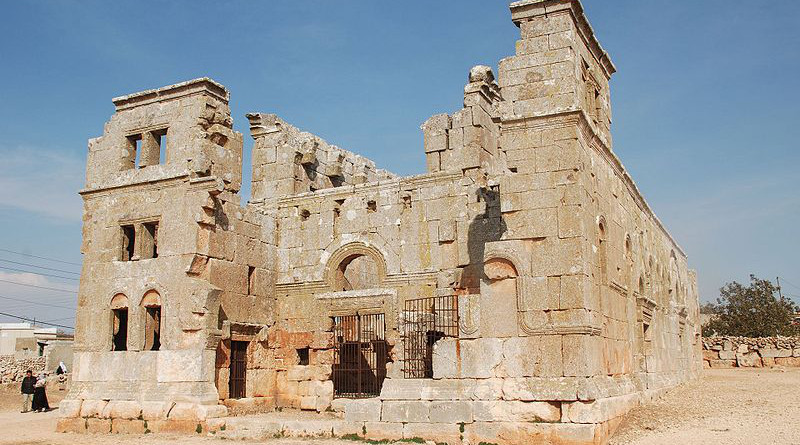‘Gothic’ Architects Brought Islamic World To Europe – OpEd
By Arab News
By Chris Doyle*
Too many people conceive the world in terms of civilizational silos. The West, whatever that means, is for many the apogee of mankind’s cultural achievements, in contrast with places like Africa, which is viewed as an uncivilized cultural blob rather than a rich and diverse array of peoples and histories. As for the Islamic world, the key word is “threat.” Any spread of its civilization undermines Judeo-Christian values, whatever they are. Islam must be kept out of Europe, as if it had never been present or contributed to its culture.
Such blinkered ignorance is not confined to far-right and uber-nationalist groups. In art historian Sir Kenneth Clarke’s much-lauded 1969 TV series “Civilisation” and the accompanying book, the author succeeds in imagining civilization as an almost totally Western European product. He makes no reference to influences from the Middle East, despite its clear and obvious impact. And, according to a 2019 poll, most Americans do not realize they use Arabic numerals and do not want them taught in US schools.
Just imagine how such narrow-minded souls view the latest book demonstrating how much Europe borrowed and benefited from Islamic civilization and the advances it made. Diana Darke outlines in great detail in “Stealing from the Saracens: How Islamic Architecture Shaped Europe” how European Gothic architecture had its roots in the Near East. What fueled her desire to write the book was the fire at Notre-Dame cathedral in Paris last year and the way the building was widely described as being a beacon of French culture, with no appreciation that its roots were far from entirely European. Darke highlights how early Syrian churches, notably the 5th century Qalb Lozeh in Idlib, used many features that were replicated at Notre-Dame centuries later.
Most of the key features of what is so misleadingly termed “Gothic” architecture did not come from Europe. On top of that, Gothic is an absurd term that should be dropped, given that the Goths were more known for destruction than construction and certainly were not in the business of designing pointed arches, ribbed vaulting or domes. All of these features and more could, on the other hand, be found on early Christian and Islamic buildings centuries before they were seen in Europe.
This is no new realization, as the author is at pains to point out. The great architect of St. Paul’s Cathedral in London, Christopher Wren, was clear. He said: “Modern Gothic… is distinguished by the lightness of its work, by the excessive boldness of its elevations, and of its sections; by the delicacy, profusion, and extravagant fancy of its ornaments… it can only be attributed to the Moors; or what is the same thing, to the Arabians or Saracens.” Italian Renaissance architect Filippo Brunelleschi was influenced by the great Islamic scientist Ibn Al-Haytham (965-1040), who many see as the father of modern optics. Brunelleschi’s double dome at Florence cathedral — a feature developed earlier by the Seljuk Turks — was the first of its kind in Europe. The Hagia Sophia in Istanbul was the largest cathedral in the world for centuries and influenced Michelangelo and Wren, among others. Antoni Gaudi, in designing his masterpiece the Sagrada Familia in Barcelona, was open about how he borrowed from Islamic architecture.
Take perhaps the most celebrated feature of Gothic architecture — the pointed arch. These featured at the highly powerful abbeys of Monte Cassino and then Cluny in the 12th century, from where their use spread swiftly across Europe. But the earliest known use of the pointed arch was at the Dome of the Rock in Jerusalem, built in 691-2.
Stained glass windows also originated in modern-day Syria but came to adorn Notre-Dame and other cathedrals in Europe. Colored glass was used on the Dome of the Rock and also the Umayyad Mosque in Damascus. The earliest known example of colored glass in Europe was at La Mezquita de Cordoba (Spain was the prime entry point for many architectural and other innovations from the Islamic world).
Aside from the pointed arch, architectural imports to Europe included the double dome, rose windows, cloisters, vaulting, ablaq (the use of alternate stone colors), and even windmills, which were first used in Persia more than 500 years before arriving in Europe. These features are widely on display for those who look, from Venice — a city more oriental than European — to Burgos, Chartres, Notre-Dame, St. Paul’s and even the Palace of Westminster.
European architecture owes a huge debt to the Islamic world that goes largely unacknowledged. Spain and Portugal, in particular, endeavor to bury their Islamic past. The cultural appropriation is stunning. You can visit La Mezquita and be excused for not knowing it was a mosque. Arabic guides were nonexistent both there and at the Alhambra in Granada when I last visited.
But this is not the key point. Science never belongs to one civilization or empire. Great strides forward are made through borrowing and building on others’ discoveries. Islamic architecture borrowed heavily from its Byzantine and early Christian forbears. Notre-Dame is not rooted in French architecture but the cumulative advances across the then-known world.
This offers a vital lesson for the present, not least as certain countries try to nationalize attempts to produce a coronavirus vaccine and monopolize the credit. All the greatest technological and scientific achievements of the past occurred when open minds sought knowledge from every avenue and collaborated. It is closed societies that fail time and time again. It is time to learn some lessons from our shared history.
- Chris Doyle is director of the London-based Council for Arab-British Understanding. Twitter: @Doylech

